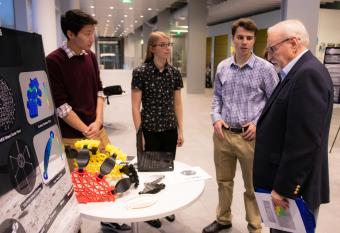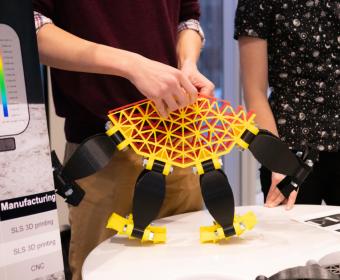Manufacturing competition challenges students to design a new lunar rover wheel

Team CLOVER's Erchis Erdenebat, Claire Thomas and Gage Gellerman present their lunar rover wheel to one of the judges during the Manufacturing Innovation Challenge finals on Dec. 5.
The last time NASA landed a rover on the Moon, its wheels were made of flexible wire mesh. Stiff inner frames were added to prevent too much deflection and thin tread strips to provide better traction.
The wheel’s mission was simple: ferry astronauts and equipment across the dusty lunar surface.
But what if the wheels on the next lunar rover could do more? What if they could take samples of the Moon’s surface as they rolled along?
A group of Mines students tackled that very question in the inaugural Manufacturing Innovation Challenge, sponsored by the Advanced Manufacturing Program.
The top design – winner of the challenge’s $3,000 grand prize announced Dec. 5 – was a collapsible 3D-printed wheel that would act almost like a “Ferris wheel of test tubes.”

Each of Team CLOVER’s aluminum and titanium wheels would be equipped with a shovel to scoop up small samples of the lunar regolith. With every revolution, the shovel would then pour the collected sample into one of the wheel’s attached test tubes.
“The inspiration for our design came from the kids’ toy that you throw like a frisbee but deploys into a ball when thrown – we thought its deployment mechanism was really unique,” mechanical engineering junior Claire Thomas said.
Rounding out Team CLOVER – short for CoLlapsible GrOund Truthing RoVER Wheel – were fellow mechanical engineering juniors Gage Gellerman and Erchis Erdenebat.
“We joined the competition as we thought it would be a fun way to extend ourselves beyond our class and get an opportunity to both learn more about additive manufacturing and make something cool that we could be proud of,” Thomas said. “We know we had some amazing competition, so we’re all extremely proud and glad the judges saw the uniqueness of our design.”
Second place and $2,000 went to Team R.O.L.L.E.R. for their Rotational On-Demand Lunar Laboratory for Extraterrestrial Research, which featured a combination of passive and active sampling techniques. Team members were Adam Marcinkowski, Charlie Fuller, Bradley Jesteadt and Deep Joshi.
Team GRATR won third place and $1,000 for their cheese grater-inspired design, with a built-in auger to move soil samples from the wheel into the rover itself. Forming the team were Kyle Barras, Zachary Howell and Adam Hugo.
All of the designs had to meet four requirements: support a maximum load of two astronauts with deflection of no more than 10 percent; pack down for transport at no more than 50 percent of its unpacked volume; have a mechanism that can be used to sample the soil as it moves; and prove economically viable in terms of fabrication cost and schedule.
Judging the final competition were Charles M. Rash, president of Griffin Systems & Technology; Roger McNamara, director at Lockheed Martin Space Systems; and Steven Harford, chief technologist at Ball Aerospace.
“Our goal for this competition was to inspire students to take modern design and manufacturing approaches and apply them to a 50-year-old solution to see what could be improved. And, of course, add a new wrinkle with the addition of the constraint that the wheel design must also sample the soil as it moves,” said Craig Brice, director of the Advanced Manufacturing Program. “The designs the students came up with were incredibly creative and I was impressed with how far they were able to take their designs with only one semester to work on it.”




